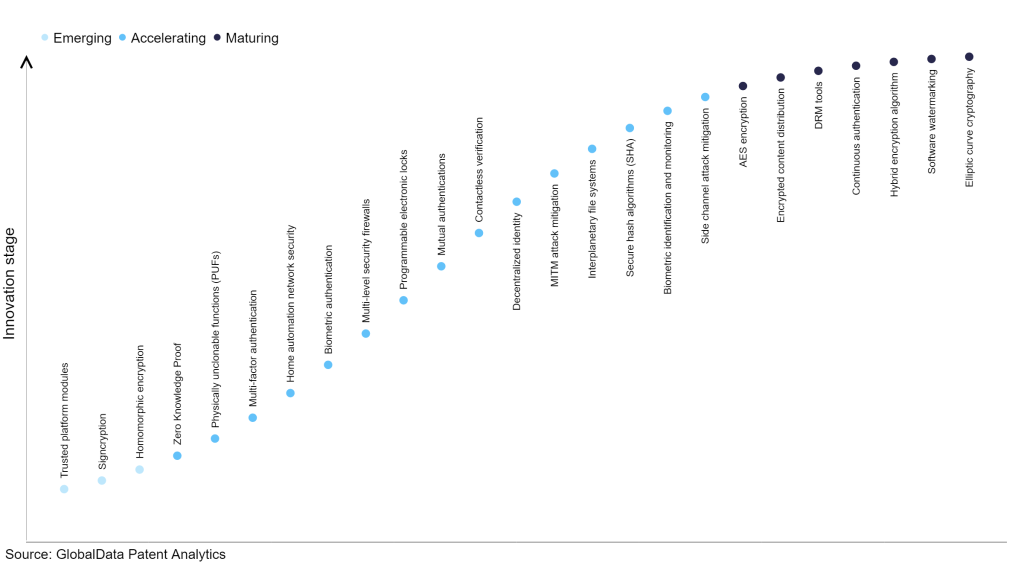The technology industry continues to be a hotbed of patent innovation. Activity is driven by the need for stronger and more comprehensive cybersecurity measures to protect against cyber threats and attacks, and growing importance of technologies such as face recognition, iris recognition, retina recognition, voice recognition, and behavioral biometrics. These technologies have facilitated the digital transformation of enterprises, but have also created various threats such as security breaches and unauthorized data access, demanding more attention on cybersecurity. In the last three years alone, there have been over 4.1 million patents filed and granted in the technology industry, according to GlobalData’s report on Cybersecurity in technology: biometric authentication. Buy the report here.
However, not all innovations are equal and nor do they follow a constant upward trend. Instead, their evolution takes the form of an S-shaped curve that reflects their typical lifecycle from early emergence to accelerating adoption, before finally stabilizing and reaching maturity.
Identifying where a particular innovation is on this journey, especially those that are in the emerging and accelerating stages, is essential for understanding their current level of adoption and the likely future trajectory and impact they will have.
190+ innovations will shape the technology industry
According to GlobalData’s Technology Foresights, which plots the S-curve for the technology industry using innovation intensity models built on over 1.5 million patents, there are 190+ innovation areas that will shape the future of the industry.
Within the emerging innovation stage, trusted platform modules, signcryption, and homomorphic encryption, are disruptive technologies that are in the early stages of application and should be tracked closely. Zero knowledge proof, physically unclonable functions (PUFs), and multi-factor authentication are some of the accelerating innovation areas, where adoption has been steadily increasing. Among maturing innovation areas are AES encryption and encrypted content distribution, which are now well established in the industry.
Innovation S-curve for cybersecurity in the technology industry

Biometric authentication is a key innovation area in cybersecurity
Biometric authentication is a security procedure that employs distinct physiological or behavioural traits to validate an individual's identity. This authentication method commonly entails the utilisation of devices like fingerprint scanners, voice recognition systems, or facial recognition technology to ascertain and confirm the identity of a person.
GlobalData’s analysis also uncovers the companies at the forefront of each innovation area and assesses the potential reach and impact of their patenting activity across different applications and geographies. According to GlobalData, there are 780+ companies, spanning technology vendors, established technology companies, and up-and-coming start-ups engaged in the development and application of biometric authentication.
Key players in biometric authentication – a disruptive innovation in the technology industry
‘Application diversity’ measures the number of applications identified for each patent. It broadly splits companies into either ‘niche’ or ‘diversified’ innovators.
‘Geographic reach’ refers to the number of countries each patent is registered in. It reflects the breadth of geographic application intended, ranging from ‘global’ to ‘local’.
Patent volumes related to biometric authentication
Source: GlobalData Patent Analytics
Apple is the top patent filer in biometric authentication, followed by Oppo and Alibaba. Apple’s hardware-based key manager Secure Enclave is isolated from the main processor to provide an extra layer of security. The biometric security architecture strictly separates the responsibilities between the biometric sensor and the Secure Enclave, while maintaining a secure connection between the two. The sensor captures the biometric image and transmits it to the Secure Enclave which processes, encrypts, and stores the face ID and touch ID template data.
The Secure Enclave compares incoming data from the biometric sensor against the stored templates to determine the authenticity of the data provided for unlocking the device.
Other prominent patent filers in the space include NEC and Intel.
In terms of geographic reach, Licentia leads the pack, followed by Magic Leap and Apple. Licentia also holds the top position in terms of application diversity followed by Cirrus Logic and Panasonic.
Biometric authentication is important to consider privacy concerns and ensure appropriate safeguards are in place to protect biometric data from unauthorized access or misuse, making it a valuable tool for ensuring security and privacy in numerous scenarios.
To further understand how cybersecurity is disrupting the technology industry, access GlobalData’s latest thematic research report on Cybersecurity.
Data Insights
From

The gold standard of business intelligence.
Blending expert knowledge with cutting-edge technology, GlobalData’s unrivalled proprietary data will enable you to decode what’s happening in your market. You can make better informed decisions and gain a future-proof advantage over your competitors.







